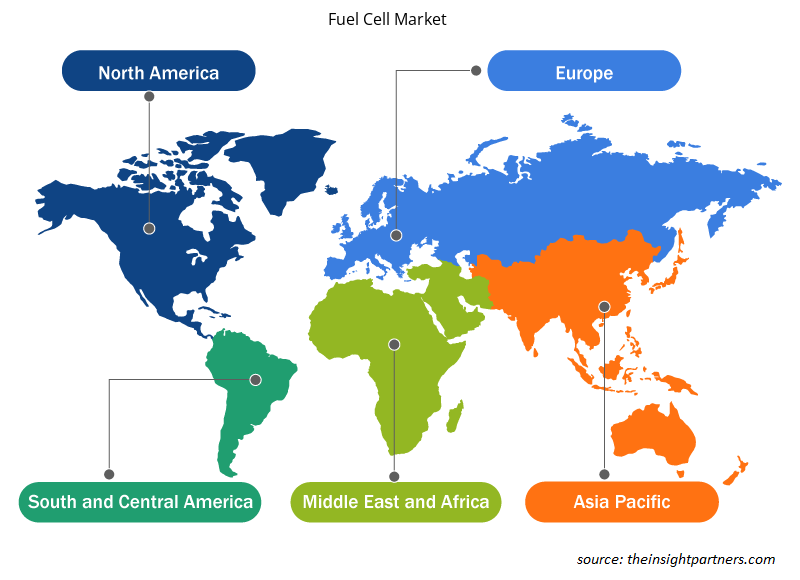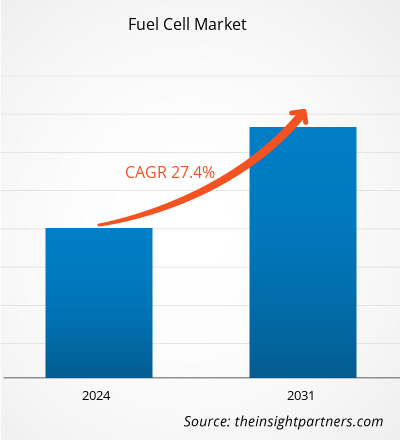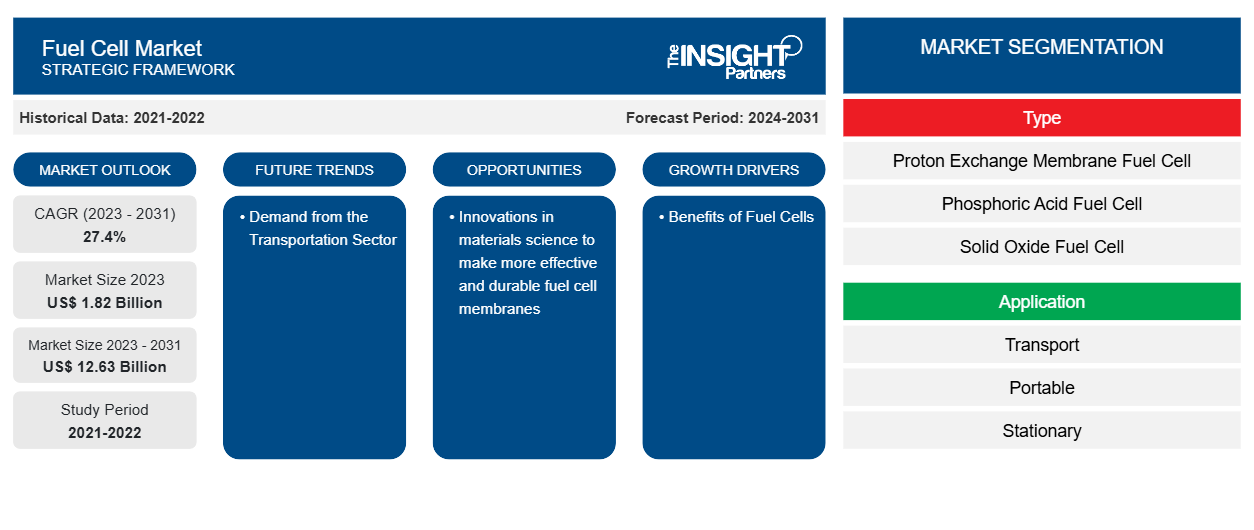燃料电池市场规模预计将从 2023 年的 18.2 亿美元增至 2031 年的 126.3 亿美元。预计 2023-2031 年市场复合年增长率将达到 27.4%。燃料电池相对于传统燃烧技术的优势以及对非常规能源日益增长的需求可能仍是燃料电池市场趋势的关键。
燃料电池市场分析
消费者对非传统能源的需求不断增长是主要驱动因素之一。为了减少对环境的影响,预计燃料电池技术的需求将会增加。预计各国政府将以各种形式支持这些进步,例如资助研发计划和适当的融资计划。此外,政府为促进电动汽车市场而采取的举措和投资将进一步促进市场增长。
燃料电池市场概览
燃料电池利用氢或其他燃料的化学能高效、清洁地发电。如果使用氢作为燃料,唯一的副产品是热、水和电。燃料电池的潜在用途范围使其独一无二;它们可以使用各种燃料和原料为大到公用发电厂、小到笔记本电脑的系统供电。
定制此报告以满足您的需求
您可以免费定制任何报告,包括本报告的部分内容、国家级分析、Excel 数据包,以及为初创企业和大学提供优惠和折扣
- 获取此报告的关键市场趋势。这个免费样品将包括数据分析,从市场趋势到估计和预测。
燃料电池市场驱动因素和机遇
燃料电池优势受市场青睐
燃料电池可用于为各种应用提供动力,包括交通运输、工业/商业/住宅建筑以及可逆系统中的长期电网储能。与传统的基于燃烧的技术相比,燃料电池具有许多优势。此外,它还用于各种发电厂和车辆。它的运行效率高于内燃机,将燃料中的化学能直接转化为电能,效率超过 60%。与内燃机相比,燃料电池的排放量更少甚至为零。氢燃料电池只排放水,可应对严峻的气候挑战,而不会排放二氧化碳。在运行时也不会产生引起雾霾或健康问题的空气污染物。燃料电池运行时非常安静,因为它们几乎没有运动部件。
交通运输行业的需求
燃料电池市场是一个快速扩张的行业,提供许多不同的商业机会。技术总是在不断发展,新的设计和材料可以提高性能和效率。因此,燃料电池在更广泛的用途中越来越有吸引力。燃料电池市场是交通运输领域最大的市场之一。与电池电动汽车 (BEV) 相比,燃料电池电动汽车(FCEV) 具有许多优势,包括续航里程更长、加油时间更短。随着 FCEV 成本的下降和氢基础设施的扩大,燃料电池汽车的市场份额预计将快速增长。未来几年政府为促进电动汽车市场而采取的各种举措可以为燃料电池市场的增长创造巨大的机会。
燃料电池市场报告细分分析
有助于得出燃料电池市场分析的关键部分是类型、应用和最终用户。
- 根据类型,市场细分为质子交换膜燃料电池 (PEMFC)、磷酸燃料电池 (PAFC)、固体氧化物燃料电池 (SOFC) 等。质子交换膜燃料电池 (PEMFC) 部分在 2023 年占据了较大的市场份额。
- 根据应用,市场分为运输、便携式和固定式。固定式部分在 2023 年占据了更大的市场份额。
- 根据最终用户,市场分为燃料电池汽车、公用事业、国防和其他。公用事业部门在 2023 年占据了更大的市场份额。
燃料电池市场份额(按地区)分析
燃料电池市场报告的地理范围主要分为五个地区:北美、亚太、欧洲、中东和非洲、南美/南美和中美。
就收入而言,亚太地区在 2023 年占据了最大的燃料电池市场份额。雅马哈、丰田等汽车制造商正在采取措施鼓励燃料电池技术,从而推动亚太地区燃料电池市场的增长。例如,2023 年 1 月,丰田秉承“为所有人创造幸福”的使命,致力于为建立一个与自然和谐相处的“面向未来”的可持续社会做出贡献,一直在开发绿色清洁技术,促进各地区的可持续发展。作为电动和其他绿色汽车技术的先驱,该公司致力于提供一系列电动和替代燃料汽车,以最大限度地减少二氧化碳排放,同时考虑到每个国家/地区的能源生产、基础设施准备情况和消费者采用情况。此外,丰田在全球范围内致力于到 2050 年实现碳中和,并计划到 2035 年实现制造业务的净零碳排放。
燃料电池市场区域洞察
Insight Partners 的分析师已详细解释了预测期内影响燃料电池市场的区域趋势和因素。本节还讨论了北美、欧洲、亚太地区、中东和非洲以及南美和中美洲的燃料电池市场细分和地理位置。

- 获取燃料电池市场的区域特定数据
燃料电池市场报告范围
| 报告属性 | 细节 |
|---|---|
| 2023 年的市场规模 | 18.2亿美元 |
| 2031 年市场规模 | 126.3亿美元 |
| 全球复合年增长率(2023 - 2031) | 27.4% |
| 史料 | 2021-2022 |
| 预测期 | 2024-2031 |
| 涵盖的领域 | 按类型
|
| 覆盖地区和国家 | 北美
|
| 市场领导者和主要公司简介 |
|
燃料电池市场参与者密度:了解其对业务动态的影响
燃料电池市场正在快速增长,这得益于终端用户需求的不断增长,而这些需求又源于消费者偏好的不断变化、技术进步以及对产品优势的认识不断提高等因素。随着需求的增加,企业正在扩大其产品范围,进行创新以满足消费者的需求,并利用新兴趋势,从而进一步推动市场增长。
市场参与者密度是指在特定市场或行业内运营的企业或公司的分布情况。它表明在给定市场空间中,相对于其规模或总市场价值,有多少竞争对手(市场参与者)存在。
在燃料电池市场运营的主要公司有:
- 康明斯公司
- FuelCell Energy, Inc.
- 插头电源公司
- 布鲁姆能源
- 巴拉德动力系统
- SFC 能源公司
免责声明:上面列出的公司没有按照任何特定顺序排列。

- 了解燃料电池市场顶级关键参与者概况
燃料电池市场新闻和最新发展
通过收集主要和次要研究后的定性和定量数据来评估燃料电池市场,其中包括重要的公司出版物、协会数据和数据库。以下是市场发展列表:
- 2023 年 9 月,印度石油天然气和住房及城市事务部部长在德里的 Kartavya Path 为第一辆绿色氢燃料电池巴士举行了揭幕仪式,这是迈向绿色出行的重要一步。(来源:石油天然气部,新闻稿,2023 年)
- 2024 年 3 月,美国领先的氢燃料电池技术开发商和零排放重型燃料电池电动汽车 (FCEV) 全球供应商 Hyzon (NASDAQ: HYZN) 在一场由政府官员、重型车队运营商以及公司员工和高管出席的仪式上,推出了其单堆 200kW 燃料电池系统和动力系统。 (来源:PR Newswire,新闻稿,2024 年)
- 2024 年 1 月,印度空间研究组织在其轨道平台 POEM3 上成功测试了 100 W 级聚合物电解质膜燃料电池电源系统 (FCPS),该平台于 2024 年 1 月 1 日搭载 PSLV-C58 发射。该实验的目的是评估聚合物电解质膜燃料电池在太空中的运行情况,并收集数据以促进未来任务系统的设计。在 POEM 上的短时间测试期间,储存在机载高压容器中的氢气和氧气产生了 180 W 的电力。它提供了有关构成电源系统的各种静态和动态系统的性能以及其中的物理原理的大量数据。(来源:印度空间研究组织,新闻稿,2024 年)
燃料电池市场报告范围和交付成果
“燃料电池市场规模和预测(2021-2031)”报告对以下领域进行了详细的市场分析:
- 范围内涵盖的所有主要细分市场的全球、区域和国家层面的市场规模和预测
- 市场动态,如驱动因素、限制因素和关键机遇
- 未来的主要趋势
- 详细的 PEST/波特五力分析和 SWOT 分析
- 全球和区域市场分析涵盖关键市场趋势、主要参与者、法规和最新市场发展
- 行业格局和竞争分析,涵盖市场集中度、热点图分析、知名参与者和最新发展
- 详细的公司简介
- 历史分析(2 年)、基准年、预测(7 年)及复合年增长率
- PEST和SWOT分析
- 市场规模、价值/数量 - 全球、区域、国家
- 行业和竞争格局
- Excel 数据集
近期报告
相关报告
客户评价
购买理由
- 明智的决策
- 了解市场动态
- 竞争分析
- 客户洞察
- 市场预测
- 风险规避
- 战略规划
- 投资论证
- 识别新兴市场
- 优化营销策略
- 提升运营效率
- 顺应监管趋势





















 获取免费样品 - 燃料电池市场
获取免费样品 - 燃料电池市场